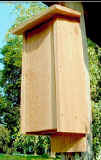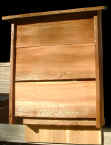|
These attractively wood-burned bat houses are designed with vertical
roosting chambers for utmost acceptance by the bats. These houses are built rock
solid for years of enjoyment. A Excellent Gift or addition to your own property!
The bat houses are more effective
when hung in pairs. Allows for a larger colony to be established. If the insect
population on the property is moderate, two houses should suffice. If insect
population is very dense I recommend using four homes placed at least two acres
apart.
Bats are some the most misunderstood creatures on the
planet. However they are also among the most necessary and beneficial
creatures on the planet. Superstition and folklore about bats has resulted
in destruction of these creatures and their habitats due to fear. Bats are
very important to our planet's ecosystem as plant pollinators and insect
predators.
Bats are important in nature, and terribly gothic. If you
want to increase the bat population around your house, there are two basic
things you can do:
1.Grow plants which attract night-flying insects and
2.Provide roosting areas for bats.
Bats can consume up to 500 insects an hour, including
mosquitoes (although mosquitoes make up only about 10% of their diet).
The health hazard to humans is small, since very few bats actually
carry rabies. Only ten people in thirty years have gotten rabies from a
bat bite.
The main hazard comes from bats roosting inside the house, which can be
a source of histoplasmosis. However, in the wild, bat populations are
declining, and natural roosting areas are being destroyed
Important things to remember:
Hang the house 12-15 feet above ground in an
area where it gets morning sun, but is in shade during the afternoon, and
is relatively protected from the wind. The house also needs to be placed
about 20 feet from the nearest tree... this is apparently to reduce
their chances of getting hit by lightning. Place the bat house near a
water source, or provide one nearby-- and make sure it's protected from
cats.
Don't be discouraged if you don't attract bats
right away....sometimes it takes quite a bit of time before a bat
population will establish itself in an area, but once they do, they
usually return.
BATS IN THEIR HOME:
Bats are a migrating species, but remain in some warmer
states year round. Bats may occupy your bat house within 1 to 7 months
after box placement, however additional time is often required to secure a
full house of bats. If you check your house each two to three weeks and do
not notice any occupancy, move the house to a new location during the
beginning of the next summer, early as March. This will allow the next
migrating group to find your box within the best time frame. Check for
occupancy by shining a strong flashlight up inside the nesting area.
Sun Exposure
Houses where high temperatures in July average 80 F, or less, should
receive at least 10 hours of sun; more is better. At least six hours of
direct daily sun are recommended for all bat houses where daily high
temperatures in July average less than 100 F.
Habitat
Most nursery colonies of bats choose roosts within 1/4
mile of water, preferably a stream, river, or lake. Greatest bat house
success has been achieved in areas of diverse habitat, especially where
there is a mixture of differing agricultural use and natural vegetation.
Bat houses are most likely to succeed in regions where bats are already
attempting to live in buildings.
Mounting
Bats find houses mounted on poles or buildings more than twice as fast
as on trees, which are also less preferred. Houses mounted on metal siding
have not been used. Wood or stone buildings with proper solar exposure are
ideal, and locations under the eaves often have been successful. Mounting
two bat houses back to back, 3/4 inch apart on poles, both covered by a
tin roof, helps protect from overheating in hot climates. All bat houses
should be mounted at least 10 feet above ground; 15-20 feet is better. Bat
houses should not be lit by bright lights.
Protection from Predators
Houses mounted on sides of buildings or high up on poles
provide the best protection from predators. This may be a key factor in
determining bat choice. Locations at least 16-25 feet from the nearest
tree are best. However, houses may be found more quickly if located along
forest or water edges where bats tend to fly.
Avoiding Uninvited Guests
Open-bottom houses greatly reduce problems with birds, mice, squirrels,
or parasites, and guano does not accumulate inside.
FAQ's
Is it safe to put up bat houses? Statistically,
it's safer than owning a dog or planting flowers. Flowers attract bees
whose stings account for far more human fatality than bats. Just banning
bicycles or swimming pools would be hundreds of times more effective in
saving lives, but how safe do we really want to be?
Which kinds of bats are attracted to bat houses, and
what are the risks and benefits? In the northern United States and
Canada, little brown and big brown bats are the most frequent bat house
users, and their safety records speak for themselves. In southern areas,
the two most frequent bat house users are twilight bats (Nycticeius humeral is) and Mexican free-tailed bats. The twilight bat has a perfect
safety record, and even free-tailed bats are far safer than having dogs in
a neighborhood. Children should be warned to leave bats alone, just as
they learn to leave bees and unfamiliar dogs alone.
Bats that live in our yards, in addition to eating pests,
serve as natural insect repellents. Many yard pests, especially moths that
attack gardens, lawns, and shrubs, can hear bats from over 100 feet away
and attempt to avoid them by leaving the area.
Should bats be tolerated or encouraged in our
neighborhoods?
There are clear benefits to sharing our neighborhoods with
bats, but as with any wild animal, they never should be tolerated in our
living quarters. Most bats that enter living areas are lost youngsters
with no greater interest than a safe escape. They can be chased out
through an open door or window or caught in a butterfly net, a leather
gloved hand, or a coffee can slowly placed over them while a piece of
cardboard is slid between the bat and wall. Rabies testing is expensive
and unnecessary unless a possible rabies exposure has occurred.
In the vast majority of cases, exclusion of bats from
human living quarters is simple, inexpensive, and can be accomplished by
the homeowner with minimal instruction. Exclusion of bats from an entire
building is also feasible in most cases, though professional advice may be
needed. More than 80% of bat colonies living in buildings go undetected by
human occupants, but large colonies can cause odor or noise problems that
justify exclusion. Some people simply exclude bats from entering living
quarters while permitting them to remain in outer walls or in unused
attics.
When bats must be entirely excluded from a building,
providing an adequate-sized bat house nearby can resolve a nuisance
without sending it to a neighbor. Without such an alternative, evicted
bats will attempt to move into a neighbor's home, or sicken and die,
increasing the probability of being picked up by children or pets.
How can human living quarters be protected against bat
entry?
Most bats that wander into human living quarters enter
through a loose-fitting door to the outside or an attic, an open window,
an unscreened chimney, or a gap in an outside wall. They must have spaces
at least 3/4-inch in diameter or 3/8 by 7/8 of an inch to enter. A room by
room search will quickly reveal such possible entry points. Holes or
crevices are easily plugged with steel wool or taped over. Chimneys can be
covered with half-inch hardware cloth screening, and loose fitting doors
may be fitted with draft guards. Unlike rodents, bats do not chew holes,
so are easily excluded. Even when bat colonies cannot be excluded from
structurally deficient walls or attics, they can be kept out of human
living areas.
Are there risks of people overreacting to news of
rabies in bats?
The incidents of a bat having rabies is no greater than any
other wildlife.
Rabies incidents involving bats are often distorted during
media reporting. When risks are not kept in perspective, panicked people
overreact in ways that increase rather than decrease the risk of rabies.
Attempts to poison or exclude bats from buildings by inappropriate methods
can dramatically increase human contact, as sick or homeless bats scatter
to exposed positions throughout an entire neighborhood.
Efforts to kill or evict bats invariably center on
colonial species. Silver-haired bats, in undisturbed habitats, closely
resemble big and little brown bats in both roosting and feeding behavior.
In urban settings, silver-haired bats are apparently less able to compete
with the more colonial species and are thus scarce. When frightened humans
declare war on bats, they may actually help silver-haired bats by reducing
their primary competitors.
The public needs to recognize the inescapability and
desirability of coexisting with bats, as well as how to minimize contact
and associated risks. Collaboration between bat researchers and
conservationists and public health and animal control officials is
essential to progress.
|






